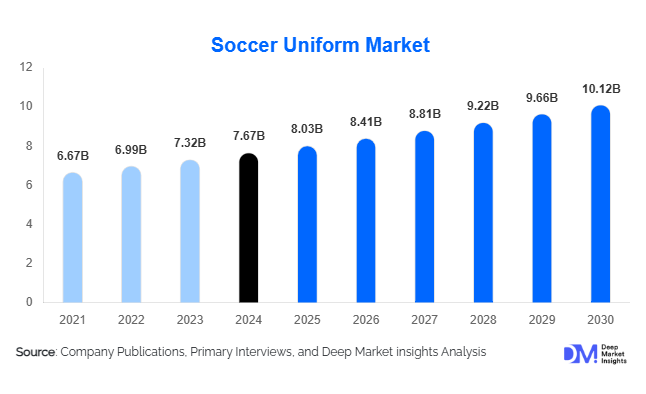Global Soccer Uniform Market to Reach USD 10.12 Billion by 2030 Driven by Rising Fan Demand, Sustainability, and Digital Sales

According to Deep Market Insights, "The global soccer uniform market, valued at USD 7.67 billion in 2024, is projected to grow from USD 8.03 billion in 2025 to USD 10.12 billion by 2030, expanding at a CAGR of 4.73% during the forecast period." Growth is fueled by increasing participation in grassroots and professional football, the expansion of global fanbases, and strong demand for replica jerseys, performance kits, and personalized fanwear.
Market Transformation
Soccer uniforms have shifted beyond functional sports apparel to become cultural and identity-driven products. Clubs and brands are leveraging fashion collaborations, sustainable materials, smart kits, and e-commerce-first strategies to capture both athletes and global fans. Demand spans performance wear for players and lifestyle fanwear, with replica jerseys generating high-volume sales through retro drops, influencer campaigns, and exclusive digital launches.
Men’s uniforms remain the largest revenue segment, while women’s and youth categories are growing faster due to the rise of professional women’s leagues, grassroots academies, and inclusive sizing initiatives.
Direct-to-consumer (D2C) channels are now the fastest-growing sales avenue, with elite clubs prioritizing exclusive kit drops, AR try-ons, and mobile-first customization. Europe leads the market with frequent kit launches and regulatory-driven sustainability measures, while Asia-Pacific is the fastest-growing region due to digital fandom and expanding e-commerce access. North America is experiencing accelerated growth ahead of the 2026 FIFA World Cup, driven by MLS, NWSL, and youth participation.
Key Growth Drivers
-
Global Commercialization of Football: Increased broadcasting deals, sponsorships, influencer tie-ins, and major tournaments drive consistent jersey turnover. Player transfers such as Lionel Messi to Inter Miami highlight how star athletes rapidly boost merchandise demand.
-
Fan Customization: Kits designed with cultural elements, retro influences, and sponsor tie-ins are in demand. Adidas’ Euro 2024 cultural kits lifted D2C sales by 20%.
-
Sustainable & High-Performance Fabrics: Brands are developing recycled polyester, biodegradable packaging, and smart textiles offering biometric feedback. Nike’s 2025 Barcelona kit, made from ocean-bound plastic, reflects this shift.
Restraining Factor
The counterfeit market continues to undermine licensed kit sales, especially in Asia, Africa, and Latin America. Despite blockchain authentication and QR tagging, counterfeit jerseys erode brand trust and revenue. In 2024, Hong Kong Customs seized HK$52 million worth of fake kits in a three-week operation.
Market Segmentation
-
By Type: Player kits, replica jerseys, training/warm-up apparel, goalkeeper uniforms, referee uniforms, women’s-specific kits.
-
By Material: Polyester, cotton blends, recycled/sustainable fabrics, nylon/spandex mix.
-
By End User: Men, women, youth/kids, unisex.
-
By Distribution Channel: Online retail, sports retail chains, club merchandise stores, supermarkets/hypermarkets, D2C platforms.
-
By Price Range: Low (mass market), mid (standard editions), premium (authentic kits, limited editions).
Regional Insights
-
Europe remains the core market, with Barcelona, Liverpool, and Juventus launching up to five kit variants annually. Regulatory pressure ensures sustainable and ethically sourced uniforms.
-
UK: Strong fan loyalty and high jersey turnover, with legacy-driven kit storytelling.
-
Germany: Sustainability-focused consumers demand recycled fabrics and ethical sourcing.
-
-
Asia-Pacific is the fastest-growing region, led by India’s grassroots participation, Japan’s innovation-driven J-League kits, and expanding e-commerce. Clubs like PSG and Manchester United now operate pop-up stores and academies across Asia.
-
North America is experiencing record demand, boosted by the upcoming FIFA World Cup and surging MLS/NWSL popularity. U.S. demand is strengthened by youth enrollment and the cultural crossover of jerseys into lifestyle fashion.
-
Latin America maintains deep cultural ties to jerseys, where uniforms act as symbols of identity beyond matchdays. Brazil exemplifies this, with jerseys integrated into daily streetwear and art-inspired collaborations.
Recent Developments
-
Adidas (March 2024): Launched culturally inspired Euro 2024 kits, driving significant fan engagement.
-
Nike (July 2025): Released carbon-neutral Barcelona kit using ocean-bound plastic.
-
Hong Kong Customs (June 2024): Seized counterfeit jerseys valued at HK$52 million.
Key Players
The market is moderately consolidated with leading players including:
Nike Inc., Adidas AG, PUMA SE, Under Armour Inc., Amer Sports, 361sport, ANTA Sports, ASICS Corp., Columbia Sportswear, Hanesbrands, Kappa, LiNing, Lululemon Athletica, Mizuno Corp., PEAK, Ralph Lauren, VF, Xtep, Umbro, Billabong, Gap Inc.
Outlook
The soccer uniform industry is set to maintain steady growth as brands align with sustainability mandates, expand D2C engagement, and develop performance-driven smart fabrics. With soccer’s rising global influence, uniforms are now positioned as both high-performance gear and cultural identity products, creating opportunities for recurring fan-driven revenue worldwide.








